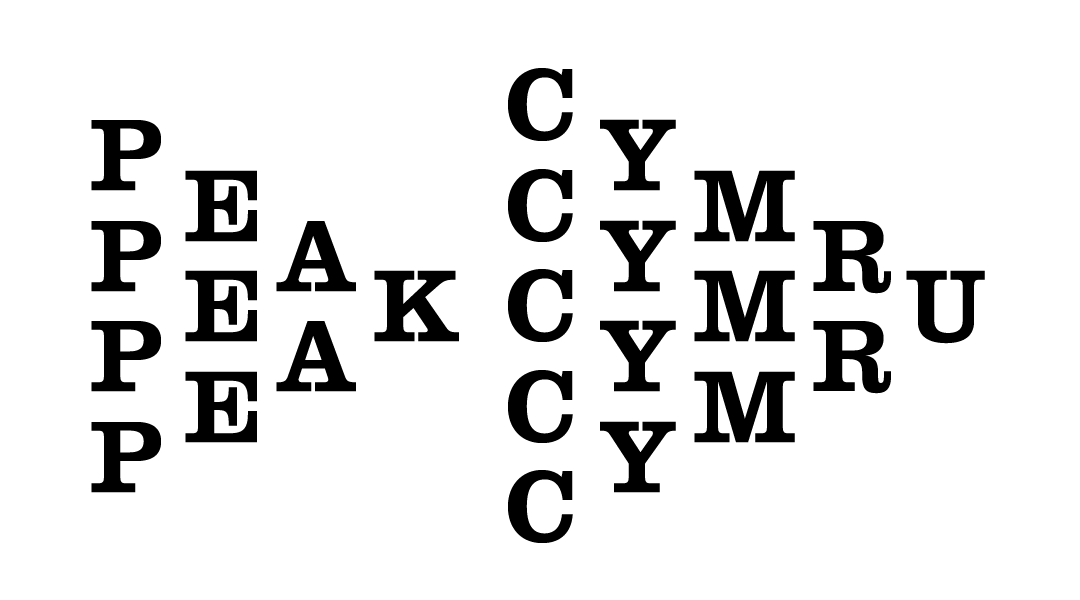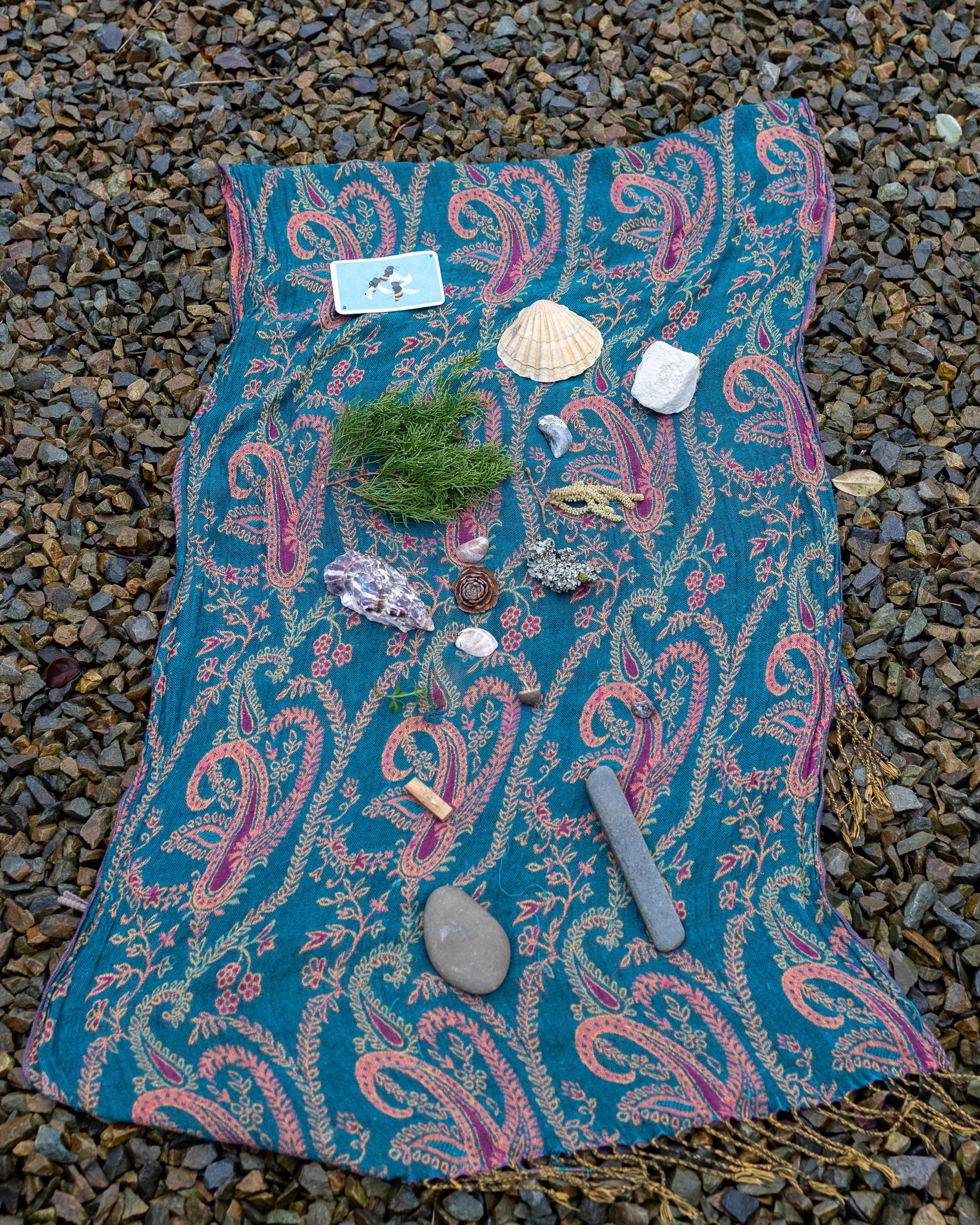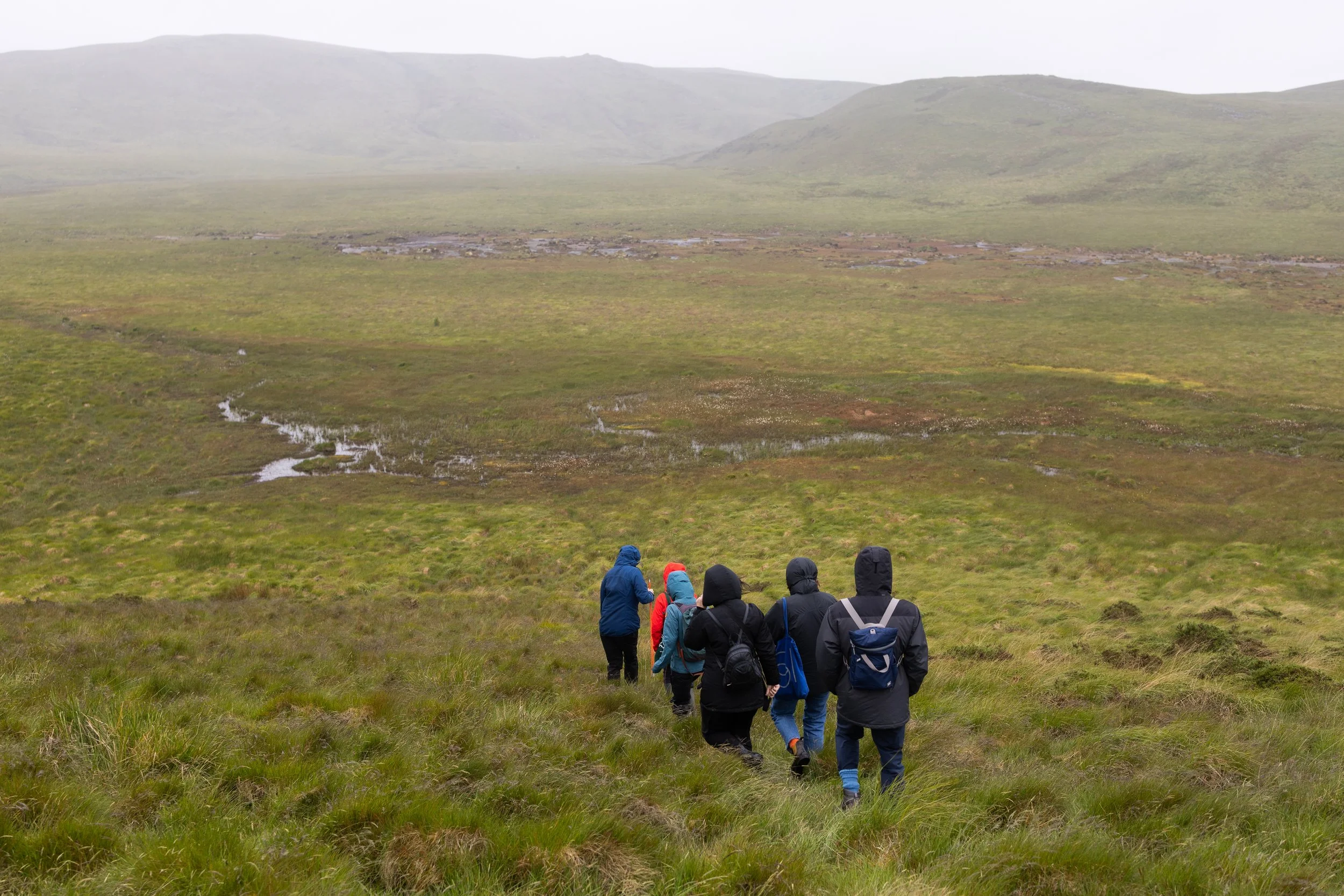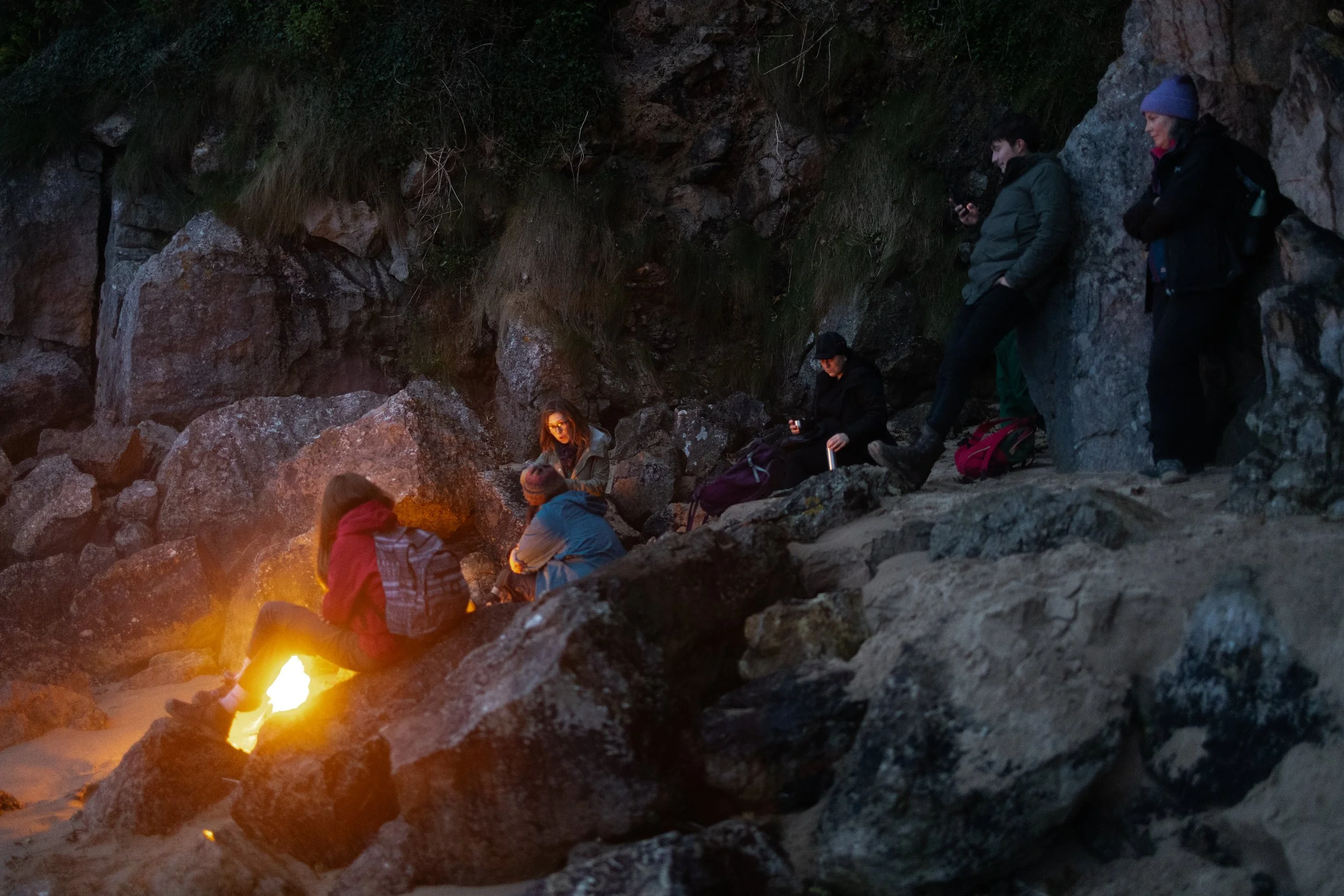Cymrodoriaeth Cymru’r Dyfodol \ Future Wales Fellowship
Dros 2024 rydym wedi bod yn cefnogi’r wyth artist sy’n cymryd rhan yng Nghymrodoriaeth Cymru’r Dyfodol, gan weithio mewn partneriaeth â Chyngor Celfyddydau Cymru, Cyfoeth Naturiol Cymru, Ymddiriedolaeth Cwm Elan a’r Ymddiriedolaeth Genedlaethol. Mae’r Gymrodoriaeth yn cefnogi artistiaid i ddatblygu ymchwil sy’n archwilio’r berthynas gymhleth rhwng pobl, natur, lle, a hinsawdd.
Across 2024 we’ve been supporting the eight Wales-based artists participating in the Future Wales Fellowship, working in partnership with the Arts Council of Wales, Natural Resources Wales, the Elan Valley Trust and National Trust. The Fellowship supports artists to develop research exploring the complex relationship between humans, nature, place and climate.
In February we gathered for the very first residential, meeting at National Trust’s Stackpole site. We met and walked with ecologists, rangers and curators, and we heard from each Future Wales Fellowship artist – Manon Awst, Cheryl Beer, Zillah Bowes, Eric Lesdema, Alison Neighbour, Simmy Singh, Julia Thomas and Iestyn Tyne - as they began thinking, imagining, researching and making.
Each artist shared their starting point with us, summarised at the bottom of this page.
Our second residential was held at the Elan Valley in June, where we explored the site and learnt about Peat in Penglaneinion and about farming within the context of conservation. We welcomed guest facilitators to share their practices and create a space for the fellows to reflect and expand their threads of knowledge.
Writer Dylan Huw led a session on shared and collective experiences of “inbetweenness” – of language, work, identity and beyond – to prompt a different kind of exchange of practice and thinking.
Rachel Solnick convened our second day together, taking us through her own and each other’s Land Storiesdrawing on identity, belonging and rootedness in relation to land. Each artist was also invited to listen deeply to nature and our surroundings in the Elan Valley before then bringing individual creative work together to make a collective composition.
With a beautiful backdrop of autumnal colours, colder air, leaves under foot and crashing waves, we returned to Stackpole for our final residential in early October.
Following an initial session with facilitator Jên Angharad, our focus for this residential was back on the artists, providing each a space to share their research and practice with each other through a creative session, walk or activity, and discussion.
We participated in Cheryl Beer’s Artist Research Trail – Sonic Nature: Sensing the Garden of Wales.
Eric Lesdema shared his latest works and research with us, informed through discussion with a range of thinkers and collaborators, exploring questions around cyfoeth, wellbeing, and the collective imagination.
Julia Thomas took us to the Walled Garden for an In my Nature workshop exploring language, storytelling and narratives.
Manon Awst shared her work with us through a performance - presentation she’s been developing to share ‘Peaty Patterns’.
Iestyn Tyne shared his latest work and held a conversation exploring his own and the other fellows’ approaches to making concepts and art accessible to different audiences.
Alison Neighbour led us on a wet and windy silent walk to the sea, exploring edges, where the land meets the sea, the sea meets the sky and day meets the night.
Our final day started with Zillah Bowes setting an invitation to have an exchange with nature and recording this in some way – through drawing or mark-making, music or writing.
Simmy Singh took us through Autumn and Spring, sharing songs to sing together and provided a moment for the fellows to reflect on what can be let go and what seeds have been sown to take with them on the next chapter of the Future Wales Fellowship.
Manon Awst
Manon’s research – titled Connect and Stick to It – will navigate fragile ecologies and earthly materials, exploring recipes for making sculptural interventions that ‘stick’ around. Working across human and more than human processes and weaving across the different temporal entanglements within peat bogs, the research will explore ideas of stickiness and ask in what ways sticky sculptures can ‘stick’ to places and stick us to them.
Cheryl Beer
Cheryl begins from the feeling that everything is temporary, and that everything can change in a millisecond. This vulnerability, felt personally, is also shared with the ecology of everything that’s around us. Through the fellowship Cheryl is exploring ways to listen to the voice of nature. Working with spectral frequencies, and technologies that usually look for what’s absent, Cheryl looks for what’s present, notating landscapes to find physical manifestations of voice and melody.
Zillah Bowes
Within Zillah’s practice, her work is often trying to find that space which takes you elsewhere – into the body, the earth and otherworldly places. Zillah’s fellowship research is exploring ideas of environmental personhood, and the ways of thinking and imagining which these conversations and designations make possible. She hopes to work with linguists to consider ways of speaking about / to / with nature, finding new tools for interconnected communication.
Eric Lesdema
Eric’s research emerges from histories of enclosure, of both the land and the mind, working in dialogue with anthropologists, linguists and historians. Strands of thinking consider boundary lines, delineations of power, shifts from common to private interests and who shapes the narrative of how these stories are told. Eric asks who is cultivating and who is conserving, walking through histories to explore our collective psychology.
Alison Neighbour
Alison’s practice explores ecosystems of interdependence, and through her fellowship research – titled Finding Common Ground – Alison will be thinking about how we live with our disproportionate impact on the planet, questioning materials and the life cycle of physical things. Emerging ideas are considering the structures that carry us and gather us, thinking about rituals and rhythms from the everyday to the planetary.
Simmy Singh
As a composer and violinist, Simmy is interested in the potential of the concert space as a sacred place of ceremony. Drawing on the thinking of eco-philosopher Joanna Macy, and her writing on ‘The Great Turning’ as a moment to embrace new creative responses for a life-sustaining society, Simmy is exploring the potential of hosting concerts in places of nature, for and with particular beings and in collaboration with other musicians.
Julia Thomas
Julia begins with the question of what we understand as ‘human nature’, thinking about how a story is told, whose voice a story is carried by, and with whom it’s being shared. Drawing on processes of working with writers and actors, Julia will explore intergenerational relationships with Sandy Water Park (previously the site of Llanelly Steel Works), listening to different perspectives on the climate crisis through the context and personal histories of one site and its community.
Iestyn Tyne
Iestyn’s fellowship project – Llif – emerges from the piece of land, or a version of the piece of land, where Iestyn grew up. Considering ideas of succession – from the perspective of his parents being first-generation farmers - Llif will explore community voices; land use; traces of colonialism; climate change; and the richness of situated, embodied knowledge. From the falling of a single tree, Iestyn will trace ideas of land guardianship, and ask who might determine a land’s future patterns.
The Future Wales Fellowship is part of the Creative Nature Programme between Natural Resources Wales and Arts Council of Wales. The programme aims to cultivate the relationship between the arts and the natural environment, as part of a shared commitment to improve the environmental and cultural well-being of Wales. This iteration of the Future Wales Fellowship is being delivered in partnership with the Elan Valley Trust, National Trust and Peak Cymru.
Ym mis Chwefror, daethon ni at ein gilydd ar gyfer y breswylfa gyntaf un ar safle Ystagbwll yr Ymddiriedolaeth Genedlaethol. Fe aethon ni am dro gydag ecolegwyr, ceidwaid a churaduron, a chlywed gan holl artistiaid Cymrodoriaeth Cymru’r Dyfodol – Manon Awst, Cheryl Beer, Zillah Bowes, Eric Lesdema, Alison Neighbour, Simmy Singh, Julia Thomas a Iestyn Tyne – wrth iddyn nhw ddechrau meddwl, dychmygu, ymchwilio a chreu.
Rhannodd pop artist eu man cychwyn gyda ni, sydd wedi ei crynhoi ar waelod y dudalen hwn.
Cynhaliwyd yr ail breswylfa yng Nghwm Elan ym mis Mehefin, lle buon ni’n archwilio’r safle ac yn dysgu am fawn ym Mhenglaneinion ac am ffermio yng nghyd-destun cadwraeth. Croesawon ni hwyluswyr gwadd i rannu eu harferion eu hunain, gan greu lle i’r criw fyfyrio ac ehangu ar eu ffrydiau gwybodaeth.
Arweiniodd y sgwennwr Dylan Huw sesiwn ar brofiadau cyfunol o fod “rhwng” – iaith, gwaith, hunaniaeth a thu hwnt – i hybu math arall o gyfn0ewid arfer a meddwl.
Rachel Solnick fu’n cynnull yr ail ddiwrnod, gan drafod Straeon Tir – eu rhai hi a rhai ein gilydd – gan sôn am hunaniaeth a gwreiddiau mewn perthynas â’r tir. Cafodd pob artist wahoddiad i wrando’n ddwfn ar natur a’r amgylchedd yng Nghwm Elan, cyn dod â gwaith creadigol unigol at ei gilydd i greu cyfanwaith cyfunol.
Ymhlith lliwiau hyfryd yr hydref, yr aer oer, y dail dan draed a’r tonnau’n taro, aethon ni ’nôl i Ystagbwll ar gyfer y breswylfa olaf ddechrau mis Hydref.
Ar ôl y sesiwn gyntaf gyda’r hwylusydd Jên Angharad, dychwelodd ein ffocws ’nôl ar yr artistiaid yn y breswylfa yma, gan roi lle i bob un rannu ymchwil ac arfer gyda’i gilydd drwy sesiwn greadigol, taith gerdded neu weithgaredd, a thrafodaeth.
Buon ni ar Lwybr Ymchwil Artist Cheryl Beer – Sonic Nature: Sensing the Garden of Wales.
Rhannodd Eric Lesdema ei waith a’i ymchwil diweddaraf gyda ni, sydd wedi’i lywio gan drafodaeth gydag amrywiaeth o feddylwyr a chydweithwyr, gan archwilio cwestiynau am gyfoeth, llesiant, a’r dychymyg cyfunol.
Aeth Julia Thomas â ni i’r Ardd Furiog ar gyfer gweithdy In my Nature a oedd yn archwilio iaith, adrodd straeon, a naratifau.
Rhannodd Manon Awst ei gwaith gyda ni drwy berfformiad-cyflwyniad mae hi wedi bod yn ei ddatblygu i rannu ‘Gweld trwy’r Gors’.
Rhannodd Iestyn Tyne ei waith diweddaraf a chynhaliodd sgwrs yn trafod ei ymagwedd ei hunan ac ymagwedd y grŵp tuag at wneud cysyniadau a chelf yn hygyrch i wahanol gynulleidfaoedd.
Arweiniodd Alison Neighbour gerdded wlyb a gwyntog at y môr, gan archwilio ymylon, lle mae’r tir yn cwrdd â’r môr, y môr yn cwrdd â’r awyr, a’r dydd yn cwrdd â’r nos.
Dechreuodd ein diwrnod olaf gyda Zillah Bowes yn estyn gwahoddiad i gyfnewid â natur a chofnodi hyn mewn rhyw ffordd – drwy ddarlunio neu greu marciau, cerddoriaeth, neu ysgrifennu.
Aeth Simmy Singh â ni drwy’r hydref a’r gwanwyn, drwy rannu caneuon i’w cyd-ganu a rhoi eiliad i’r criw fyfyrio ar beth allwn ni ei adael i fynd, a pha hadau sydd wedi’u hau i fynd â nhw gyda nhw ar y bennod nesaf o Gymrodoriaeth Cymru’r Dyfodol.
Manon Awst
Bydd ymchwil Manon – dan yr enw Connect and Stick to It – yn llywio ecolegau bregus a deunyddiau daearol, gan archwilio ryseitiau ar gyfer creu ymyriadau cerfluniol sy’n ‘glynu’. Gan weithio ar draws prosesau dynol a mwy na dynol, a phlethu ar draws y gwahanol gysylltiadau bydol mewn corsydd mawn, bydd yr ymchwil yn archwilio syniadau am ludedd, ac yn gofyn ym mha ffyrdd gall cerfluniau gludiog ‘lynu’ i lefydd a’n glynu ni iddyn nhw.
Cheryl Beer
Mae Cheryl yn dechrau o’r teimlad bod popeth yn fyrhoedlog, ac bod modd i bopeth newid mewn llai nag eiliad. Mae’r bregusrwydd yma, sy’n cael ei deimlo’n bersonol, hefyd yn cael ei rannu gydag ecoleg popeth sydd o’n cwmpas ni. Drwy’r gymrodoriaeth, mae Cheryl yn archwilio ffyrdd o wrando ar lais natur. Gan weithio gydag amleddau sbectrol, a thechnolegau sydd fel arfer yn chwilio am yr hyn sy’n absennol, mae Cheryl yn chwilio am yr hyn sy’n bresennol, gan nodiannu tirweddau i ganfod amlygiadau corfforol o lais ac alaw.
Zillah Bowes
Mae gwaith Zillah yn aml yn ceisio dod o hyd i’r gofod yna sy’n mynd â chi i rywle arall – i mewn i’r corff, y ddaear, a mannau arallfydol eraill. Mae ymchwil cymrodoriaeth Zillah yn archwilio syniadau o bersoniaeth amgylcheddol, a’r ffyrdd o feddwl a dychmygu y mae’r sgyrsiau a’r dynodiadau yma’n eu galluogi. Mae’n gobeithio gweithio gyda ieithyddion i ystyried ffyrdd o siarad am / at / gyda natur, gan ganfod offer newydd ar gyfer cyfathrebu’n rhyng-gysylltiedig.
Eric Lesdema
Mae ymchwil Eric yn codi o hanesion amgáu, y tir a’r meddwl, gan weithio mewn deialog gydag anthropolegwyr, ieithyddion a haneswyr. Mae llinynnau meddwl yn ystyried llinellau ffin, darluniadau pŵer, symudiadau o fuddiannau cyffredin i rhai preifat, a phwy sy’n siapio naratif y ffordd caiff y straeon yma eu hadrodd. Mae Eric yn gofyn pwy sy’n meithrin a phwy sy’n cadw, gan gamu drwy hanesion i archwilio ein seicoleg gyfunol.
Alison Neighbour
Mae gwaith Alison yn archwilio ecosystemau rhyng-ddibyniaeth, a thrwy ymchwil y gymrodoriaeth – dan yr enw Finding Common Ground – bydd Alison yn meddwl am y ffordd rydyn ni’n byw gyda’n heffaith anghymesur ar y blaned, gan gwestiynu deunyddiau a chylch bywyd pethau ffisegol. Mae egin-syniadau’n ystyried y strwythurau sy’n ein cario ni ac yn ein hymgynnull, gan feddwl am ddefodau a rhythmau o’r beunyddiol i’r planedol.
Simmy Singh
Fel cyfansoddwr a feiolinydd, mae gan Simmy ddiddordeb ym mhotensial y gofod cyngerdd fel man seremoni cysegredig. Gan dynnu ar syniadaeth yr eco-athronydd Joanna Macy, a’i gwaith ysgrifennu ar ‘Y Tro Mawr’ fel cam i groesawu ymatebion creadigol newydd ar gyfer cymdeithas sy’n cynnal bywyd, mae Simmy’n archwilio potensial cynnal cyngherddau mewn mannau natur, ar gyfer a gyda bodau penodol ac mewn cydweithrediad â cherddorion eraill.
Julia Thomas
Mae Julia’n dechrau gyda’r cwestiwn ynghylch beth ydyn ni’n ei ddeall yw ‘natur ddynol’, gan ystyried sut caiff stori ei hadrodd, llais pwy sy’n cario stori, a gyda phwy mae’n cael ei rhannu. Gan ddefnyddio prosesau gweithio gydag awduron ac actorion, bydd Julia’n archwilio perthnasoedd rhyng-genhedlaeth gyda Pharc Dŵr y Sandy (hen safle Gwaith Dur Llanelli), gan wrando ar wahanol safbwyntiau ar yr argyfwng hinsawdd drwy gyd-destun a hanesion personol un safle a’i gymuned.
Iestyn Tyne
Mae prosiect cymrodoriaeth Iestyn – Llif – yn deillio o’r darn o dir, neu fersiwn o’r darn o dir, lle magwyd Iestyn. Gan ystyried syniadau o olyniaeth – o safbwynt ei rieni fel ffermwyr cenhedlaeth gyntaf – bydd Llif yn archwilio lleisiau’r gymuned; defnydd o dir; olion gwladychiaeth; newid hinsawdd; a chyfoeth gwybodaeth leoledig ac ymgorfforedig. O gwymp un goeden, bydd Iestyn yn mynd ar drywydd syniadau am warchodaeth tir, a phwy sy’n pennu patrymau’r tir yn y dyfodol.
Mae Cymrodoriaeth Cymru’r Dyfodol yn rhan o’r Rhaglen Natur Greadigol rhwng Cyfoeth Naturiol Cymru a Chyngor y Celfyddydau. Nod y rhaglen yw meithrin y berthynas rhwng y celfyddydau a’r amgylchedd naturiol, fel rhan o ymrwymiad a rennir i wella llesiant amgylcheddol a diwylliannol Cymru. Mae’r cam hwn o Gymrodoriaeth Cymru’r Dyfodol yn cael ei ddarparu mewn partneriaeth ag Ymddiriedolaeth Cwm Elan, yr Ymddiriedolaeth Genedlaethol a Peak Cymru.








